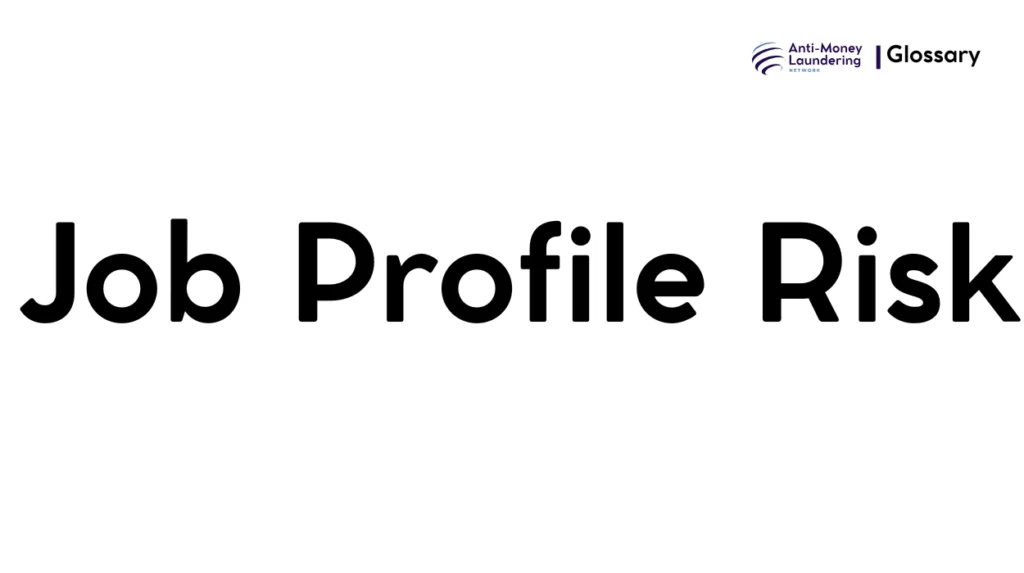Definition
Job Profile Risk in the context of Anti-Money Laundering (AML) refers to the evaluation of risk associated with the occupational or professional background of a customer or client. This risk factor assesses how the nature of a customer’s employment or job role can influence their potential involvement in money laundering, terrorist financing, or other financial crimes. It is a critical component in forming a comprehensive customer risk profile used to guide due diligence and ongoing monitoring.
Purpose and Regulatory Basis
The purpose of assessing Job Profile Risk is to identify clients who, based on their profession or occupation, present a higher or lower risk for money laundering or terrorist financing. Some occupations by nature involve higher exposure to illicit financial flows or greater vulnerability to corruption and financial crime.
Globally, AML frameworks such as the Financial Action Task Force (FATF) Recommendations, the USA PATRIOT Act, and the European Union’s Anti-Money Laundering Directives (AMLD) emphasize the importance of risk-based approaches. Under these regulations, institutions must consider all relevant risk factors — including job or professional role — to tailor their controls accordingly. This ensures that resources target higher-risk relationships effectively and that suspicious activities linked to certain professions are carefully scrutinized.
When and How it Applies
Job Profile Risk assessment occurs primarily at the customer onboarding phase and continues through periodic reviews. It applies in scenarios such as:
- Initial Customer Due Diligence (CDD): Collecting information about the client’s job or profession to classify risk.
- Enhanced Due Diligence (EDD): For clients with high-risk occupations (e.g., politicians, accountants, real estate agents), additional scrutiny is warranted.
- Ongoing Monitoring: Watching for transaction patterns inconsistent with the client’s occupation or known income sources.
For example, a client employed as a cash-intensive business operator or politically exposed person (PEP) would trigger higher Job Profile Risk, leading to more stringent checks.
Types or Variants
Job Profile Risk can vary according to sectors and roles, including but not limited to:
- High-Risk Occupations: Such as politicians (PEPs), auditors, lawyers, cash-intensive business owners (e.g., nightclub operators, casinos), and real estate professionals.
- Medium-Risk Occupations: Some financial professionals, consultants, or contractors who might access significant funds but under less direct regulatory scrutiny.
- Low-Risk Occupations: Public sector employees with regular incomes and little access to high volumes of cash.
The classification depends on geographic region, regulatory guidance, and the institution’s internal risk appetite.
Procedures and Implementation
Institutions compliant with AML standards take the following steps concerning Job Profile Risk:
- Data Collection: Obtain detailed job and employer information during customer onboarding.
- Risk Assessment: Use predefined criteria and databases to categorize the job profile risk level.
- Documentation: Record risk findings as part of the customer profile.
- Enhanced Due Diligence: Apply stricter verification and monitoring for high-risk job profiles.
- Training: Ensure staff are informed about occupational risks and factors influencing ML/TF.
- Ongoing Review: Periodically update job profile information and re-assess risk as client circumstances evolve.
Systems such as Customer Relationship Management (CRM) tools and transaction monitoring platforms integrate job profile data to automate alerts and flag unusual activity.
Impact on Customers/Clients
From a customer’s perspective, Job Profile Risk assessment:
- May lead to enhanced verification requirements.
- Could result in limitations or restrictions on transaction types or volumes if risk is high.
- Should be communicated transparently to maintain trust, emphasizing compliance rather than suspicion.
Customers have rights to privacy, but also obligations to provide accurate occupational information. Failure to disclose or misrepresentation could lead to account restrictions or closure.
Duration, Review, and Resolution
Job Profile Risk is not static. Institutions must define review intervals (e.g., annually, biennially) or triggers for earlier re-assessment, such as:
- Changes in client employment.
- Notable transactions outside expected activity.
- Updated regulatory guidance or risk models.
If a client’s job profile changes to a higher risk category, the institution escalates due diligence measures. Conversely, risk reduction may allow easing of controls.
Reporting and Compliance Duties
Financial institutions are obliged to:
- Document Job Profile Risk assessments clearly within customer files.
- Report suspicious activities that arise from inconsistencies related to job profile.
- Demonstrate compliance with applicable AML regulations during audits or regulatory inspections.
- Train employees to recognize and act on risks connected to occupational profiles.
Penalties for failure to adequately consider Job Profile Risk can include fines, sanctions, or reputational harm.
Related AML Terms
Job Profile Risk links closely with:
- Customer Risk Profiling: Broader assessment including geographic, transactional, and product risks.
- Enhanced Due Diligence (EDD): Applied when job profile or other factors increase risk.
- Politically Exposed Persons (PEPs): A subgroup often highlighted in job profile assessments.
- Transaction Monitoring: To detect deviations from expected activity patterns based on job risk.
Challenges and Best Practices
Common issues include:
- Incomplete or inaccurate job information from clients. Best practice: use multiple verification sources.
- Keeping job data updated over time.
- Balancing privacy with compliance to avoid alienating clients.
Best practices recommend strong governance, regular staff training, and integration of job profile risk within broader AML systems and controls.
Recent Developments
The AML landscape is evolving with:
- Increasing use of Artificial Intelligence (AI) and Machine Learning to analyse job data and detect anomalies faster.
- Regulations emphasizing risk-based approaches, encouraging more granular job risk classifications.
- Growing attention to emerging professions (e.g., crypto asset service providers) and their potential risks.
Institutions must adapt to these trends to maintain robust compliance.
Job Profile Risk is a vital element of AML compliance, helping institutions identify potential financial crime risks linked to a customer’s occupation. Proper assessment and management of this risk support regulatory adherence, protect financial systems, and safeguard institutions against legal penalties. For compliance officers and financial institutions, understanding and implementing effective Job Profile Risk frameworks ensures a strong defense against money laundering and terrorist financing activities.

